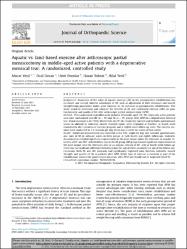| dc.contributor.author | Yeşil, Murat | |
| dc.contributor.author | Özcan, Özal | |
| dc.contributor.author | Dündar, Ümit | |
| dc.contributor.author | Toktaş, Hasan | |
| dc.contributor.author | Yeşil, Hilal | |
| dc.date.accessioned | 2022-05-11T11:41:31Z | |
| dc.date.available | 2022-05-11T11:41:31Z | |
| dc.date.issued | 16.12.2021 | en_US |
| dc.identifier.citation | Yesil, M., Ozcan, O., Dundar, U., Toktas, H., & Yesil, H. (2021). Aquatic vs. land-based exercise after arthroscopic partial meniscectomy in middle-aged active patients with a degenerative meniscal tear: A randomized, controlled study. Journal of Orthopaedic Science. | en_US |
| dc.identifier.issn | 0949-2658 | |
| dc.identifier.issn | 1436-2023 | |
| dc.identifier.uri | https://doi.org/10.1016/j.jos.2021.11.011 | |
| dc.identifier.uri | https://hdl.handle.net/20.500.12933/978 | |
| dc.description.abstract | Background
Awareness of the value of aquatic exercise (AE) in the postoperative rehabilitation has increased, and several inherent advantages of AE, such as adjustment of both resistance and muscle strengthening parameters makes good rationale for its inclusion in postoperative rehabilitation. This study aimed to determine and compare the benefits of AE and land-based exercise (LBE) on pain, functionality, and quality of life after arthroscopic partial meniscectomy (APM).
Methods
This randomized controlled study included 30 middle-aged (35–50), physically active patients who were randomized into LBE (n = 15) and AE (n = 15) groups after APM for a degenerative meniscal tear. Visual analogue scale (VAS), Short Form-36 (SF-36), single-leg hop test and Lysholm questionnaire scores in addition to isokinetic muscle strength values were evaluated at baseline, at fourth week immediately after cessation of exercise program and at eighth week follow-up visits. The exercise sessions were conducted in 1-h sessions per day, three days a week for a total of four weeks.
Results
Significant improvement was observed in the VAS, single-leg hop test, Lysholm questionnaire, and most of SF-36 subscale scores in both groups at both fourth and eighth follow-ups. Isokinetic dynamometer revealed significant improvement in the peak torque values for extension at angular velocities of 60° and 180° at both follow-ups in the AE group. LBE group showed significant improvement in the peak torque value for extension only at an angular velocity of 60° only at fourth week follow-up. There was no significant difference between groups for any of these parameters at any of the follow-ups.
Conclusion
Both AE and LBE programs had significantly improved pain, function, isokinetic muscle strength, and quality of life in patients after APM. Either type of exercise is essential as part of the rehabilitation protocol for good clinical outcomes after APM and should not be neglected (level II). | en_US |
| dc.description.abstract | Background
Awareness of the value of aquatic exercise (AE) in the postoperative rehabilitation has increased, and several inherent advantages of AE, such as adjustment of both resistance and muscle strengthening parameters makes good rationale for its inclusion in postoperative rehabilitation. This study aimed to determine and compare the benefits of AE and land-based exercise (LBE) on pain, functionality, and quality of life after arthroscopic partial meniscectomy (APM).
Methods
This randomized controlled study included 30 middle-aged (35–50), physically active patients who were randomized into LBE (n = 15) and AE (n = 15) groups after APM for a degenerative meniscal tear. Visual analogue scale (VAS), Short Form-36 (SF-36), single-leg hop test and Lysholm questionnaire scores in addition to isokinetic muscle strength values were evaluated at baseline, at fourth week immediately after cessation of exercise program and at eighth week follow-up visits. The exercise sessions were conducted in 1-h sessions per day, three days a week for a total of four weeks.
Results
Significant improvement was observed in the VAS, single-leg hop test, Lysholm questionnaire, and most of SF-36 subscale scores in both groups at both fourth and eighth follow-ups. Isokinetic dynamometer revealed significant improvement in the peak torque values for extension at angular velocities of 60° and 180° at both follow-ups in the AE group. LBE group showed significant improvement in the peak torque value for extension only at an angular velocity of 60° only at fourth week follow-up. There was no significant difference between groups for any of these parameters at any of the follow-ups.
Conclusion
Both AE and LBE programs had significantly improved pain, function, isokinetic muscle strength, and quality of life in patients after APM. Either type of exercise is essential as part of the rehabilitation protocol for good clinical outcomes after APM and should not be neglected (level II). | en_US |
| dc.language.iso | eng | en_US |
| dc.publisher | Elsevier | en_US |
| dc.relation.isversionof | 10.1016/j.jos.2021.11.011 | en_US |
| dc.rights | info:eu-repo/semantics/embargoedAccess | en_US |
| dc.rights | info:eu-repo/semantics/embargoedAccess | en_US |
| dc.title | Aquatic vs. land-based exercise after arthroscopic partial meniscectomy in middle-aged active patients with a degenerative meniscal tear: A randomized, controlled study | en_US |
| dc.type | article | en_US |
| dc.authorid | 0000-0003-4386-9120 | en_US |
| dc.authorid | 0000-0002-2784-0574 | en_US |
| dc.authorid | 0000-0002-1260-0412 | en_US |
| dc.authorid | 0000-0002-8291-1515 | en_US |
| dc.department | AFSÜ, Tıp Fakültesi, Cerrahi Tıp Bilimleri Bölümü, Ortopedi ve Travmatoloji Ana Bilim Dalı | en_US |
| dc.contributor.institutionauthor | Yeşil, Murat | |
| dc.contributor.institutionauthor | Özcan, Özal | |
| dc.contributor.institutionauthor | Dündar, Ümit | |
| dc.contributor.institutionauthor | Toktaş, Hasan | |
| dc.contributor.institutionauthor | Yeşil, Hilal | |
| dc.identifier.startpage | 1 | en_US |
| dc.identifier.endpage | 7 | en_US |
| dc.relation.journal | Journal of Orthopaedic Science | en_US |
| dc.relation.publicationcategory | Makale - Ulusal Hakemli Dergi - Kurum Öğretim Elemanı | en_US |
















